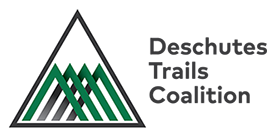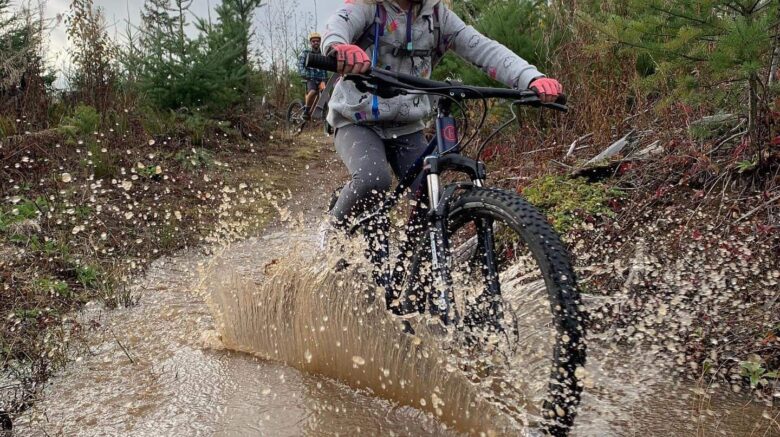RAIN, AND SNOW AND MUD, OH, MY!
December is on the horizon. In Central Oregon, that means some trail users are starting to head to the hills to sample the first snow, while some are still hitting the trails closer to town. A mixed bag of wet weather, snow and fluctuating freezing levels makes November/early December a particularly vulnerable time for trails. Mountain bikers seek ideal tacky conditions after rain events; skiers venture out on Forest Service roads that are starting to accumulate snow, yet are still open to vehicles; and hikers and trail runners carry on, despite the mud puddles. Now is a perfect time to talk about best trail use practices.
FIRST, LET’S THANK THE TRAIL FAIRIES

Before we talk about USING trails, let’s take a moment to recognize the trail fairies that take care of them. Every year, unsung heroes–nonprofits and volunteers–spend tens of thousands of hours improving hundreds of miles of Central Oregon trails. These hardy souls are still out there getting those winter and all-season trails perfectly primed. Nonprofits like Meissner Nordic, Central Oregon Nordic Club (CONC) and Central Oregon Trail Alliance (COTA) dedicate sweat and time to repair and improve trails, clear downed trees, replace and post signs, cut back brush, chop and haul firewood and repair shelters every year.
To honor those labors of love as we transition into the shoulder season, let’s talk about some best practices and seasonal restrictions – all designed to value and sustain Central Oregon’s vast natural resources, precious wildlife and recreation. What’s YOUR wet trail use IQ? Read on.
BEST MOUNTAIN BIKING PRACTICES WHEN IT’S WET
Be a Muddy Buddy.
It can precipitate quite a bit in Central Oregon between November and even June. Whether it’s after a rainy day, or a ground thaw after a hard frost, the bike-hungry want to hit those trails, rain, snow or shine. It’s hard to wait when you’re seeking those tacky trails that only come when it’s wet, but it’s a delicate balance. Riding trails when they’re wet impacts high desert trails in multiple ways, and because of the climate, has longer-lasting consequences. Before you go biking, keep these guidelines in mind:
RULES OF THE (WET) OFFROAD:
BIKING ON central oregon trails in the Fall
If It’s Wet…Wait.
Damage alert! The best thing you can do to be a good bike ambassador is to wait until the trail dries out. Check recently-reported conditions at bendtrails.org, or call a local bike shop. A good rule of thumb is wait ONE DAY FOR EVERY INCH OF RAIN. If it snows on top of previous mud and doesn’t freeze – DON’T GO!
Stay Single! Leave No Tracks.
Keep singletrack just that. Ride THROUGH puddles and standing water sections. By doing this, after the tread dries out, riders will flatten any track back out. Plus it refreshes the free soil on the surface, which means more tacky rides in your future. Riding around standing water leads to widening the trail, and increases erosion that washes that soil away. Remember, the tracks you leave teach other bikers who follow.
Keep It Smooth.
Avoid riding technical sections when it’s wet. Those challenging rocks and ledges are vulnerable when the ground is soft, and it’s easy to dislodge rocks. Even bigger features can fracture after freeze/thaw cycles that are common in Central Oregon. Stick to the smoother trails.
NOVEMBER 1st BEGINS “NO DOGS” RESTRICTIONS
We know it’s a little “ruff” for the dog owners out there, but November 1st is the day when “No Dogs” restrictions take effect in certain areas of the Deschutes National Forest. This particularly impacts the popular stretch of sno-parks and trails along the north side of the Cascade Lakes Highway: Meissner, Swampy Lakes, Vista Butte and Dutchman. It may seem innocuous to bring your pooch along despite the rule. Please don’t!
“No Dogs” closures [View the map HERE] are designed to protect the precious breeding grounds of several species that range in this area: black-tailed deer, elk and mule deer. These mammals migrate to lower elevations in late fall, when they enter “rutting season”, a time when bucks and bulls roam and look for mates with little food supply. Winter dog closures protect gestating cows and does from attacks. Not all dogs have a prey drive, but the policy is in place for those dogs that do.
MOTORIZED TRAIL USE DURING NOVEMBER

Late fall is also a time when forest roads are still open to vehicles. This is a sensitive time of year when motorized and non-motorized trail users overlap. Until December 1st, you may encounter vehicles adventuring out even when there is snow on the roads. The Forest Service has been working with some nonprofits to mediate the impacts motorized users can have on winter trail systems like Meissner Nordic by placing road barriers. Until December 1st, however, we all still must “share the road”.
The bottom line: During this time when multiple users converge and conditions shift, we encourage everyone to be a “trail ambassador”. Whether you implement these best practices yourself, or pass them along to others, your actions help to preserve thousands of hours of volunteer work, simultaneously protecting and sustaining our trails…for all.

